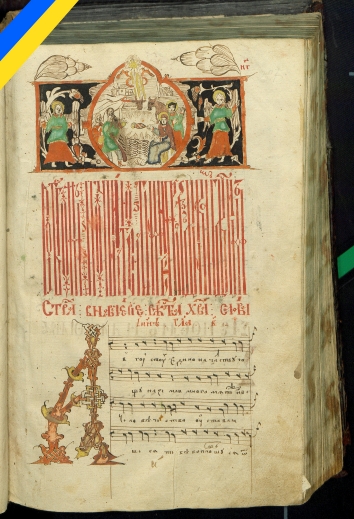
Mimořádná přednáška EMCE: Ukrajinský irmologion. Dr. Maria Kachmar, Lvov
Jedním z cílů našeho projektu je uvést na pravou míru celou řadu mýtů, které se ve výkladu starších českých hudebních dějin hluboce zakořenily během politického vývoje 19. a 20. století. Dnes jsme svědky pokusu o nastolení nových mýtů, které se tentokrát týkají starších dějin Ukrajiny.
O raném vývoji byzantské liturgie a její hudby na Kyjevské Rusi, o rukopisech, které tento vývoj dokládají a mýtech, kterými jsou tyto rukopisy obestřeny, nás seznámí mladá badatelka Dr. Maria Kachmar z Ústavu hudebních středověkých ukrajinských studií Národní hudební akademie Mykoly Lysenka ve Lvově. Jedná se o kyjevský pravoslavný chorál, jeho specifickou notaci, a více než 1500 jeho pramenech. (Anglický abstrakt níže, PDF pozvánka zde.)
Přednáška proběhne ve středu 20. dubna v 17:00 CEST na platformě Zoom. Jazykem přednášky bude angličtina.
Registrovaní účastníci obdrží odkaz emailem. Registrovat se lze zde: https://forms.gle/5FgNJii34sH7MRvv8
Abstract. The lecture provides a general introduction to a crucial part of Ukrainian history: the musical idiom associated with services in the Byzantine liturgy in Kyiv. Byzantine chant is rich in genre, including so-called canon, stycheras, and prokeienon, among others. These were all adopted in the Middle Ages in Kyiv while preserving Byzantine melodies and poetics along with Greek metrics. More than 1500 manuscripts with Ukrainian Irmologion, a genre which combines themes from the Old and New Testaments and elements of Byzantine religious poetry that were used in the Byzantine liturgy, was written between the 16th and 19th century. The chant texts present a later development of the Church Slavonic language, created by Cyril (Konstantine) and Methodius in the 9th century, featuring a specific Ukrainian dialect, documented in manuscripts from as early as the 12th and 13th centuries. Specific to these manuscripts is their notation, a local (Ukrainian) variant of the staff (lineal) notation that can aid in the reconstruction of melodies concealed in medieval manuscripts with slavic neumatic notation, today only partly readable.
Maria Kachmar, PhD, is a senior lecturer at the Department of Musical Medieval and Ukrainian Studies of The Mykola Lysenko Lviv National Music Academy (Ukraine). Her main areas of research are the Byzantine and Slavic neumatic and Kyivan linear musical notation of the 12-17th century, music paleography, and history of old ukrainian music and liturgical chants. She is a member of the KAAD scholarship in Ostkirchlichen Institut an der Universität Würzburg (2009). She received PhD in Musicology in 2016. Her published works are research about music notation in collective monographs of collection The Late 16th Century Neumatic Heirmologion of Lavriv (Lviv UCU 2019) and Viennese Oktoechos Codex Vindobonensis Slavicus 37/Research. (Kyiv 2021). Also, she is a scientific worker in Institute of Church Music UCU (https://icm.ucu.edu.ua) and teacher of the Instytut Regencki Archidiecezji Przemysko-Warszawskiej (since 2016).



